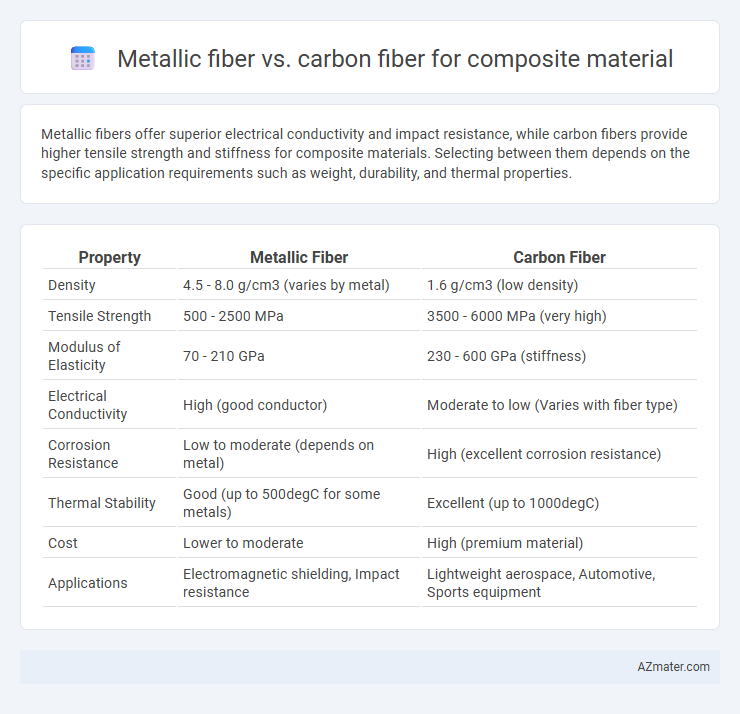Metallic fibers offer superior electrical conductivity and impact resistance, while carbon fibers provide higher tensile strength and stiffness for composite materials. Selecting between them depends on the specific application requirements such as weight, durability, and thermal properties.
Table of Comparison
| Property | Metallic Fiber | Carbon Fiber |
|---|---|---|
| Density | 4.5 - 8.0 g/cm3 (varies by metal) | 1.6 g/cm3 (low density) |
| Tensile Strength | 500 - 2500 MPa | 3500 - 6000 MPa (very high) |
| Modulus of Elasticity | 70 - 210 GPa | 230 - 600 GPa (stiffness) |
| Electrical Conductivity | High (good conductor) | Moderate to low (Varies with fiber type) |
| Corrosion Resistance | Low to moderate (depends on metal) | High (excellent corrosion resistance) |
| Thermal Stability | Good (up to 500degC for some metals) | Excellent (up to 1000degC) |
| Cost | Lower to moderate | High (premium material) |
| Applications | Electromagnetic shielding, Impact resistance | Lightweight aerospace, Automotive, Sports equipment |
Introduction to Composite Materials
Metallic fibers, often made from stainless steel or aluminum, provide composites with enhanced electrical conductivity and excellent ductility, making them suitable for applications requiring impact resistance and thermal management. Carbon fibers are favored for their high strength-to-weight ratio, stiffness, and corrosion resistance, crucial for aerospace, automotive, and sporting goods where lightweight and structural integrity are priorities. Composite materials combining these fibers create hybrid structures that optimize mechanical properties and functionality, leveraging the unique benefits of both metallic and carbon reinforcements.
Overview of Metallic Fiber
Metallic fiber composites offer superior electrical conductivity and enhanced thermal stability compared to traditional carbon fiber composites, making them ideal for applications requiring electromagnetic interference shielding and heat dissipation. These fibers, typically made from stainless steel, copper, or aluminum, provide improved ductility and impact resistance, allowing for increased durability in structural components. The integration of metallic fibers into polymer matrices also enhances mechanical properties such as tensile strength and fatigue resistance, contributing to longer-lasting composite materials.
Overview of Carbon Fiber
Carbon fiber offers superior strength-to-weight ratio and exceptional stiffness, making it ideal for high-performance composite materials in aerospace, automotive, and sports industries. Its high tensile strength and resistance to fatigue enhance durability, while its low density contributes to significant weight reduction compared to metallic fibers. Carbon fiber composites also provide excellent corrosion resistance and thermal stability, outperforming many metallic fiber alternatives in demanding applications.
Mechanical Properties Comparison
Metallic fibers exhibit high tensile strength and excellent impact resistance, making them suitable for applications requiring durability and toughness, while carbon fibers offer superior stiffness and a higher strength-to-weight ratio, essential for lightweight structural components. Carbon fiber composites typically have a modulus of elasticity between 230-600 GPa, significantly outperforming metallic fibers, which generally range around 100-300 GPa. The fatigue resistance of carbon fiber is also notably better, though metallic fibers provide greater ductility and damage tolerance under cyclic loading conditions.
Weight and Density Analysis
Metallic fiber composites typically exhibit higher density values, ranging from 7.8 to 8.9 g/cm3, compared to carbon fiber composites, which have densities around 1.6 g/cm3, making carbon fiber significantly lighter. The lower weight of carbon fiber composites enhances strength-to-weight ratios, crucial for aerospace and automotive applications where minimizing mass is essential. Conversely, metallic fibers provide greater durability but contribute to increased overall composite weight, affecting performance in weight-sensitive designs.
Corrosion and Chemical Resistance
Metallic fibers, such as stainless steel, offer excellent mechanical strength but are prone to corrosion when exposed to harsh chemical environments, especially in the presence of salts or acids. Carbon fibers exhibit superior chemical resistance and are inherently impervious to most corrosive agents, making them ideal for applications requiring long-term durability in aggressive environments. Composite materials reinforced with carbon fibers maintain structural integrity and resist degradation, whereas metal fiber composites may require additional coatings or treatments to prevent corrosion over time.
Cost and Manufacturing Considerations
Metallic fiber composites generally incur higher raw material costs but offer greater durability and thermal conductivity compared to carbon fiber composites, which are more expensive due to complex precursor materials and energy-intensive production processes. Manufacturing metallic fiber composites involves conventional metalworking techniques such as extrusion and welding, enabling scalability and easier recycling, while carbon fiber production requires specialized autoclaving and curing methods, increasing manufacturing time and costs. Cost-efficiency in composite material selection depends on application-specific durability requirements, production volume, and performance criteria, with metallic fibers preferred for cost-sensitive, high-conductivity applications and carbon fibers favored for lightweight, high-strength structures despite higher expenses.
Applications in Various Industries
Metallic fiber composites exhibit exceptional electrical conductivity and electromagnetic interference shielding, making them ideal for aerospace and automotive industries requiring lightweight, durable materials. Carbon fiber composites provide superior strength-to-weight ratios and corrosion resistance, extensively applied in sports equipment, aerospace, and renewable energy sectors for high-performance structural components. Industries prioritize carbon fiber for its stiffness and fatigue resistance, while metallic fibers are favored where thermal management and electrical functionality are critical.
Environmental Impact and Sustainability
Metallic fibers in composite materials generally exhibit higher energy consumption and carbon emissions during production compared to carbon fibers, which are lighter and offer superior strength-to-weight ratios contributing to fuel efficiency in applications like automotive and aerospace. Carbon fiber composites provide enhanced recyclability and longer service life, reducing environmental impact through lower material replacement frequency and waste generation. Sustainable advancements in carbon fiber manufacturing focus on utilizing bio-based precursors and recycling technologies to further minimize ecological footprints.
Choosing the Right Fiber for Your Project
Selecting the right fiber for composite materials hinges on project requirements such as strength, weight, and conductivity. Metallic fibers offer excellent electrical conductivity and impact resistance, making them ideal for applications requiring electromagnetic interference shielding or enhanced durability. Carbon fibers provide superior strength-to-weight ratios and stiffness, preferred in aerospace and automotive industries where lightweight and high tensile strength are critical.

Infographic: Metallic fiber vs Carbon fiber for Composite material
 azmater.com
azmater.com